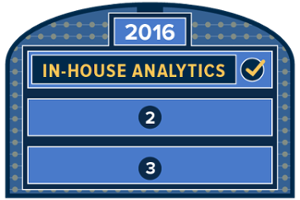In January, members of the World Economic Forum met at their annual Davos summit to discuss analytics, automation, and artificial intelligence (AI), topics with enough potential to have global business leaders expressing both optimism and fear:
"It's not like we actually have economic growth today. So we actually need technological breakthrough, we need AI ... Our responsibility is to have the AI augment the human ingenuity and augment the human opportunity." - Satya Nadella, Microsoft CEO
“I think now about how artificial intelligence will create digital refugees and how people will be displaced from jobs, tens of millions of people across the planet, because technology is moving forward so rapidly ... So companies, individuals have to decide: are we going to be committed to improving the state of the world? We’re at a crucial point right now.” - Marc Benioff, Salesforce CEO
These technologies are shaping our world quicker than experts expected, but the critical question remains: Will this trend significantly reshape the legal profession?
The short answer—as we’ve highlighted before—is yes.
For the second year in a row, the Coalition of Technology Resources for Lawyers (CTRL) and the Information Governance Initiative (IGI) teamed up to survey internal legal departments about their current and anticipated adoption of advanced analytics.
The findings? In line with last year’s study, and perhaps not surprisingly, analytics adoption is accelerating and practitioners are more bullish than ever.
What a Difference a Year Makes: 5 Findings from 2016
“Analytics Will Be Indispensable”
The overwhelming majority of respondents agreed that data analytics will be indispensable to the legal profession over the next 10 years. Ninety-nine percent of practitioners told us they thought analytics “will be very important, will be considered indispensable, and use will be widespread.”
e-Discovery Use Cases Are Changing
Culling and early case assessment took top billing as the #1 and #2 analytics use cases for e-discovery, respectively. We saw a three-way tie for the bronze spot among fact finding (which grew 9 percent compared to last year), relevancy review (despite its decrease from 71 to 60 percent), and review prioritization. Another interesting decrease to note: privilege review, which went from 57 percent to 32 percent, a decrease of 44 percent. Respondents were asked to select all the ways their team uses document review functionality in e-discovery from the following list: culling; early case assessment; fact finding; case/deposition preparation; relevancy review; privilege review; review prioritization; sampling/quality control; “I don’t know.”
 Budgets for Matter Management Are Projected to Climb
Budgets for Matter Management Are Projected to Climb
Twice as many legal departments confirmed their intention to use analytics for matter management, and 71 percent predicted increased spending. The top two use cases here remained stable, with “measuring ‘predicted’ to ‘actual’ spend” at 67 percent, and “resource allocation” at 63 percent. This year, “managing outside counsel” ousted “budgeting resources” for the #3 top spot, moving up to 63 percent (compared to 54 percent in 2016).
Analytics in Contract Review Has Caught Fire
Five times as many legal departments said they’ll start using analytics for contract review in 2017 versus last year. The number who said they’ll spend more money here rose to 54 percent from 24 percent, a 125 percent increase. The top two uses cases, consistent with last year, are “evaluating existing contracts” (58 percent) and “evaluating contracts during negotiations” (42 percent).
Analytics in Information Governance Is On the Rise
Survey respondents presently apply advanced analytics in defensible disposition (83 percent), policy and compliance (83 percent), data migration (82 percent), and automatic content categorization (72 percent). Automating content categorization saw a 50 percent increase year over year, while data migration has risen 36 percent. The number of organizations predicting increased spending in these areas rose to 66 percent.
What's Next?
We’re approaching a tipping point. Enterprise data’s explosive growth and the demands of complex regulations across the globe urge in-house counsel to leverage existing technologies and embrace emerging ones, driving the mass adoption that we see coming to fruition. The acceleration of analytics combined with the decomposition of legal tasks means that enabling technologies will be working alongside legal knowledge workers within the next decade. But the question remains: how long of a time horizon are we anticipating, particularly for a legal industry that’s been slow to adopt and adapt?
There’s more to the story than what we’ve covered here. Barclay T. Blair, executive director of the Information Governance Initiative, and I will be taking a closer look at the survey results in a 30-minute webinar on February 16. Join the conversation to better understand the in-house legal landscape of the near future.














